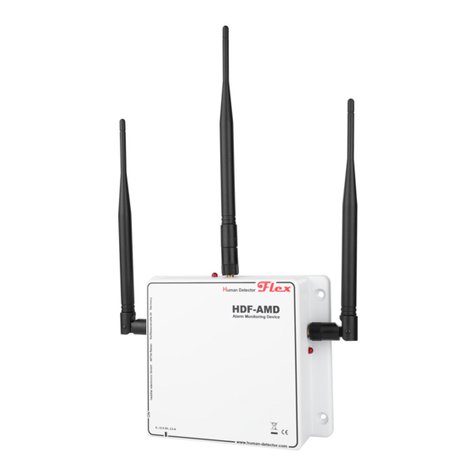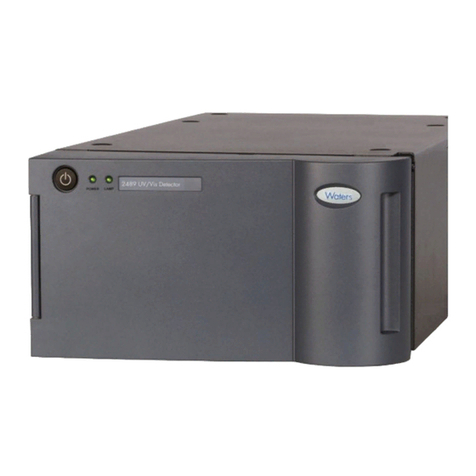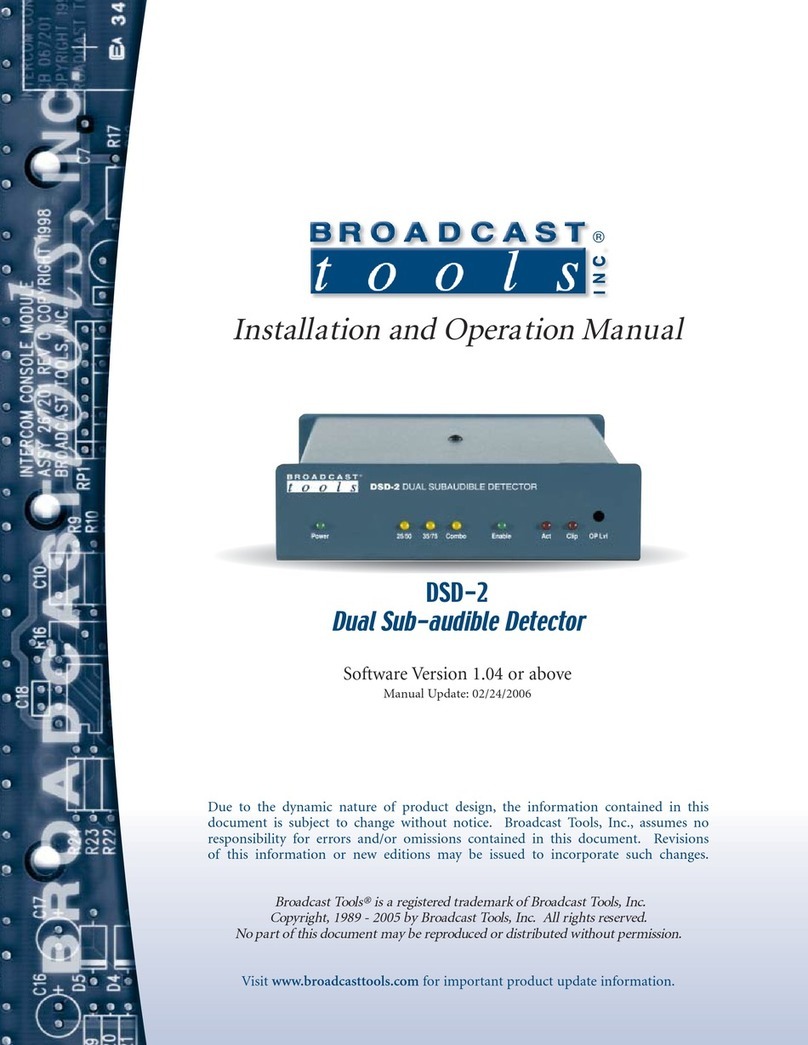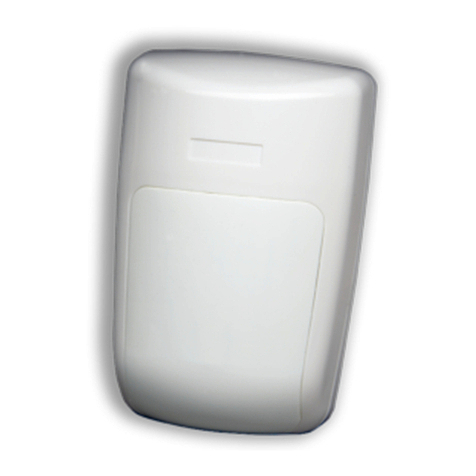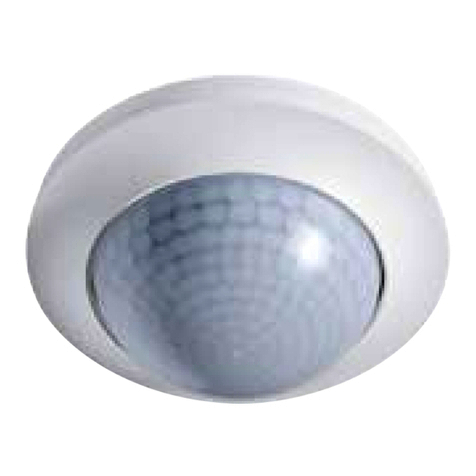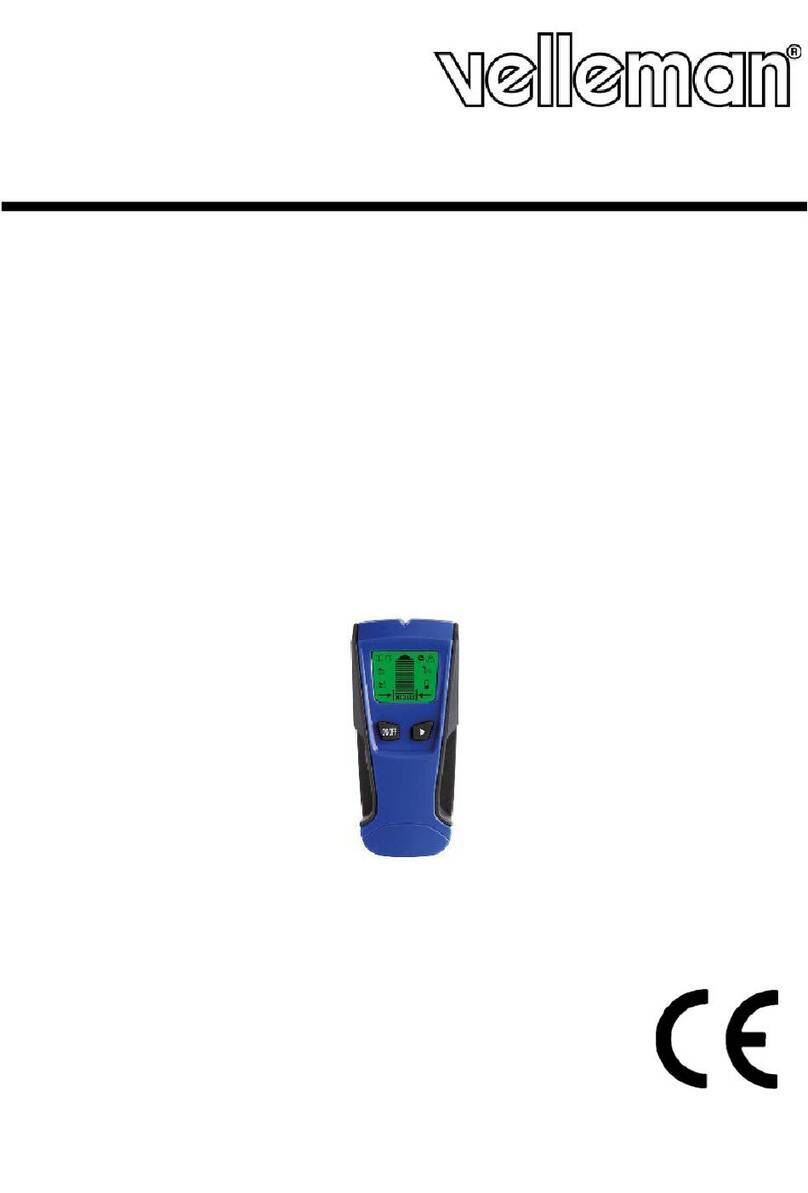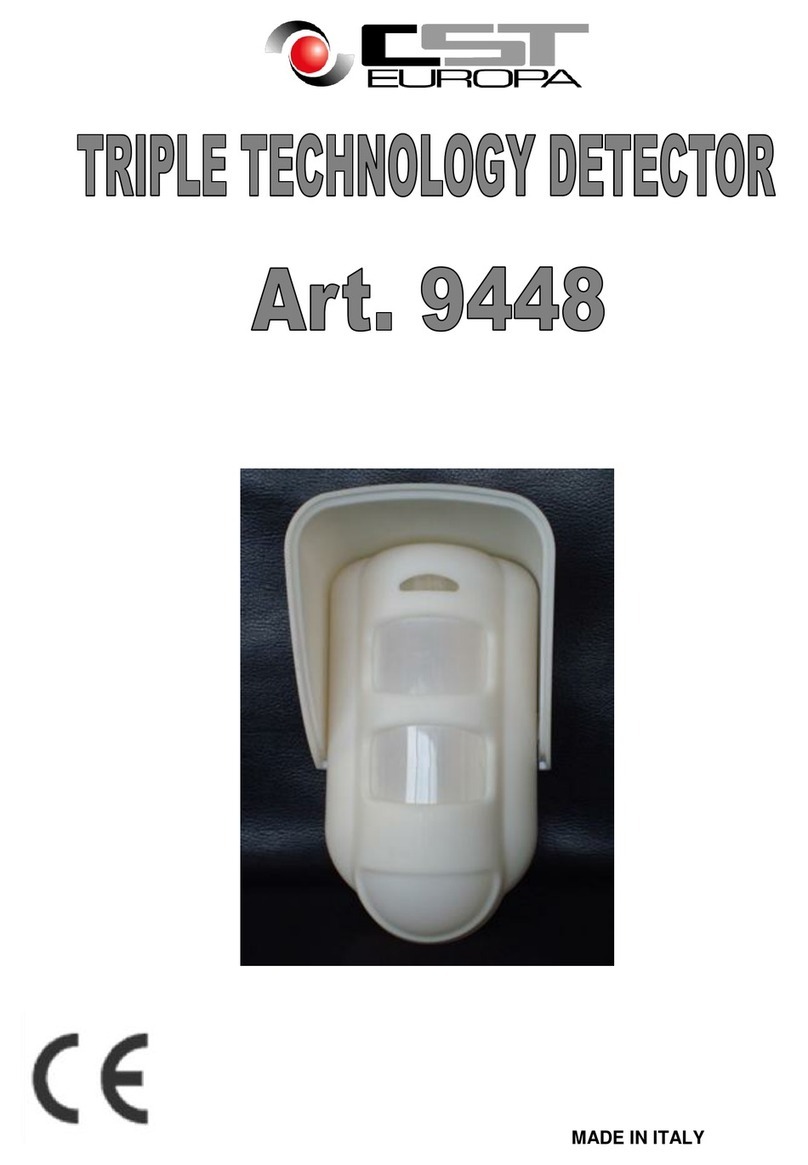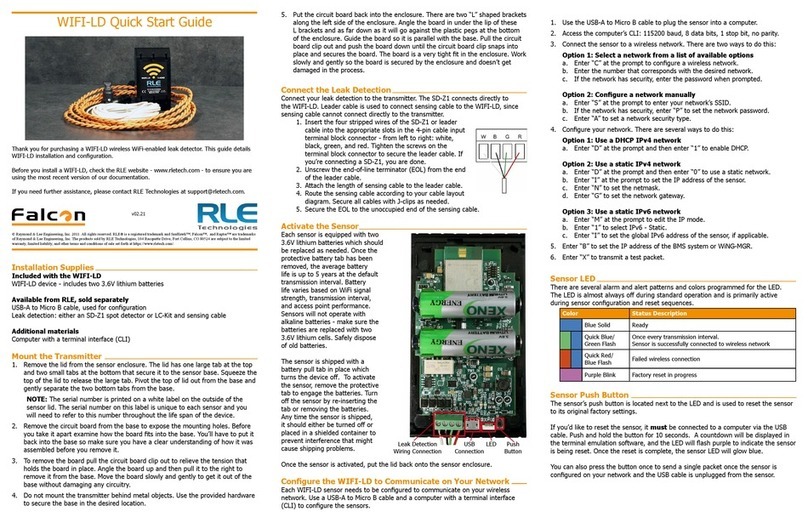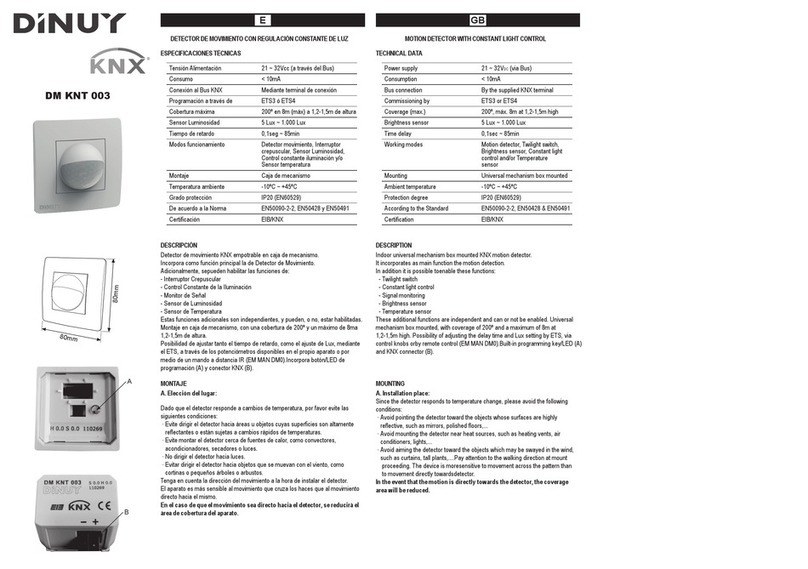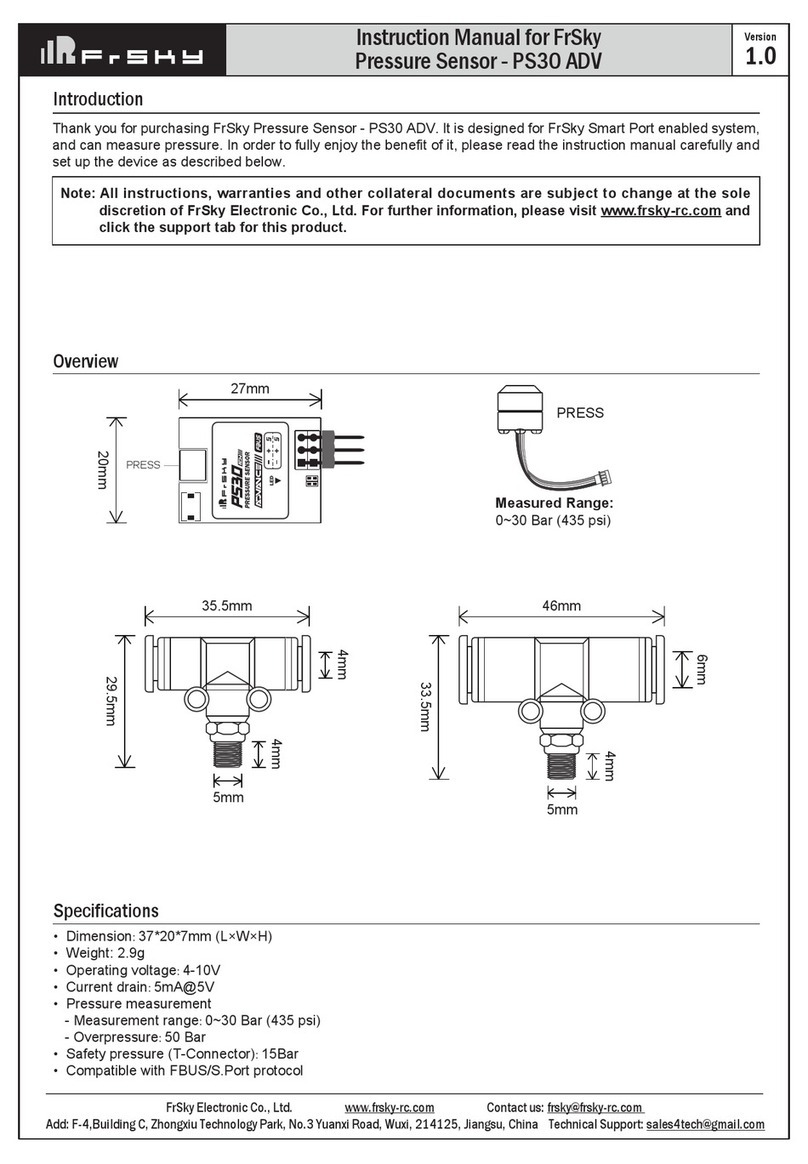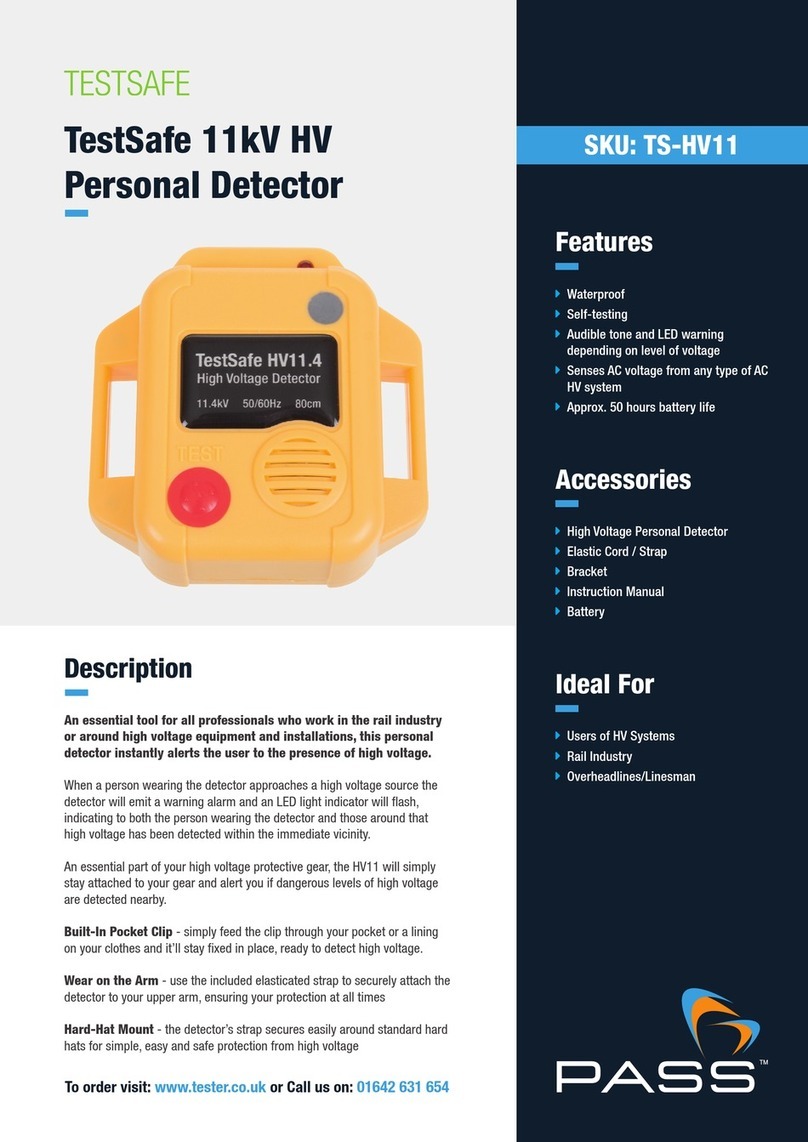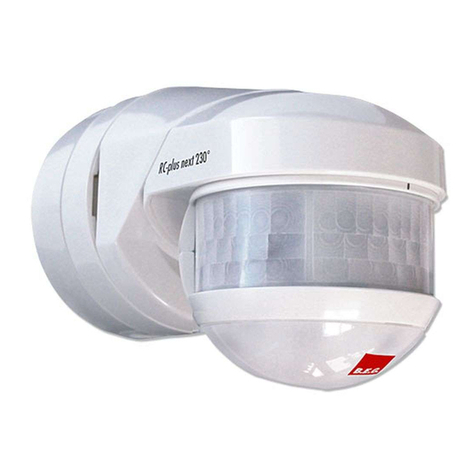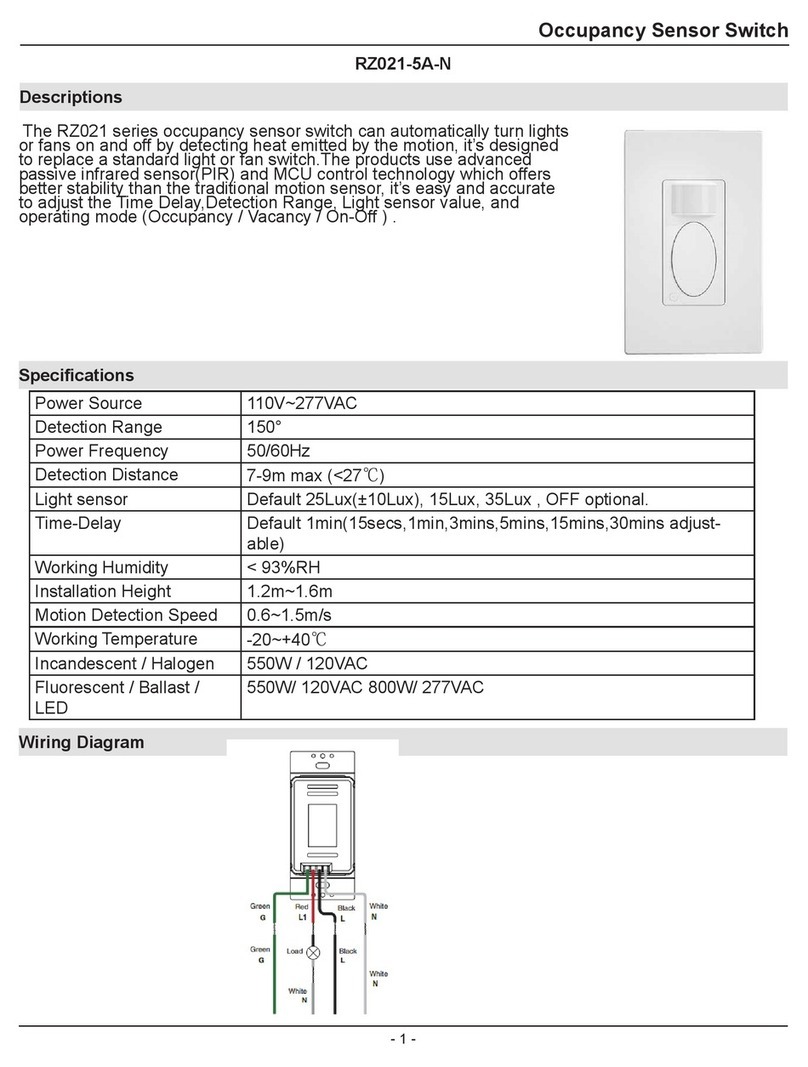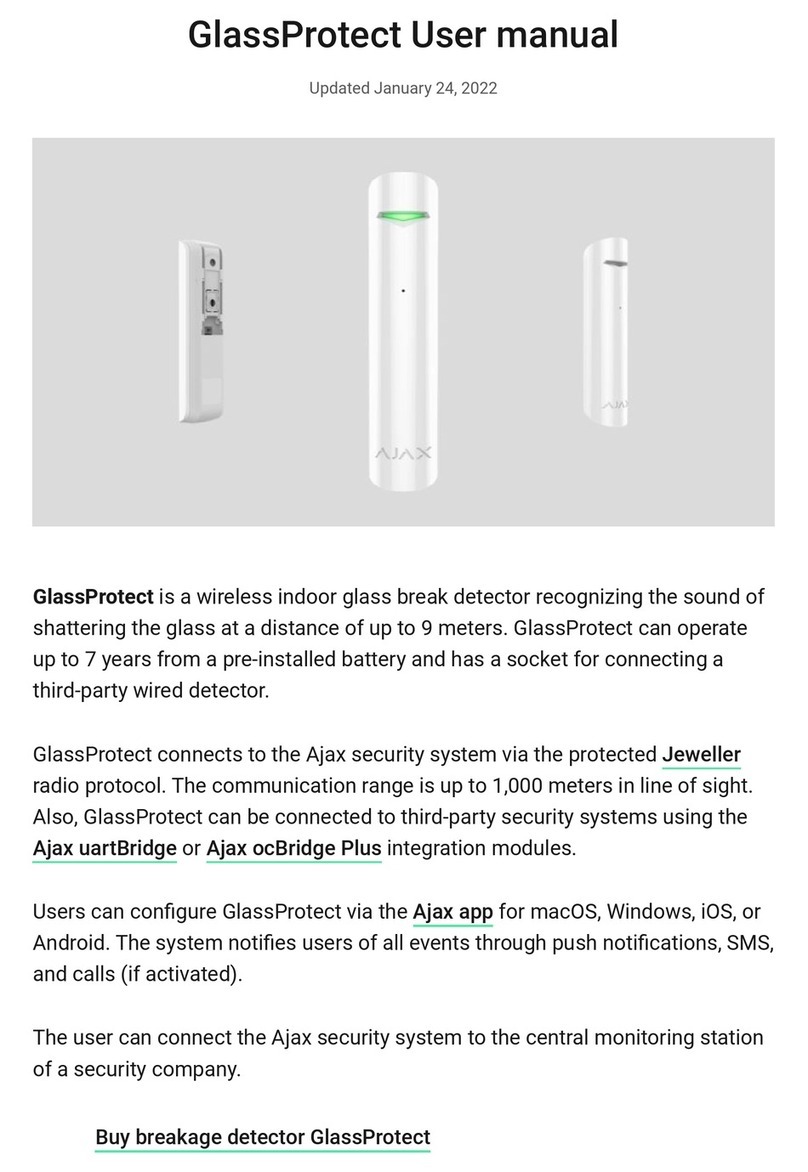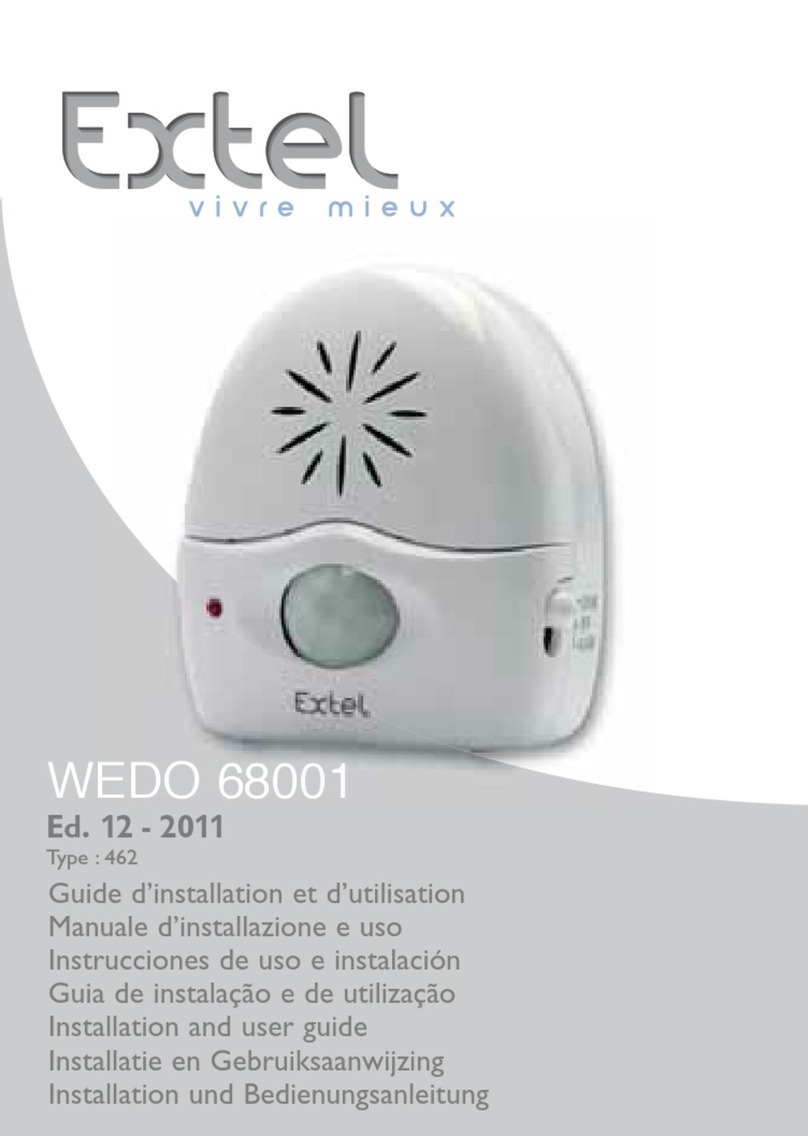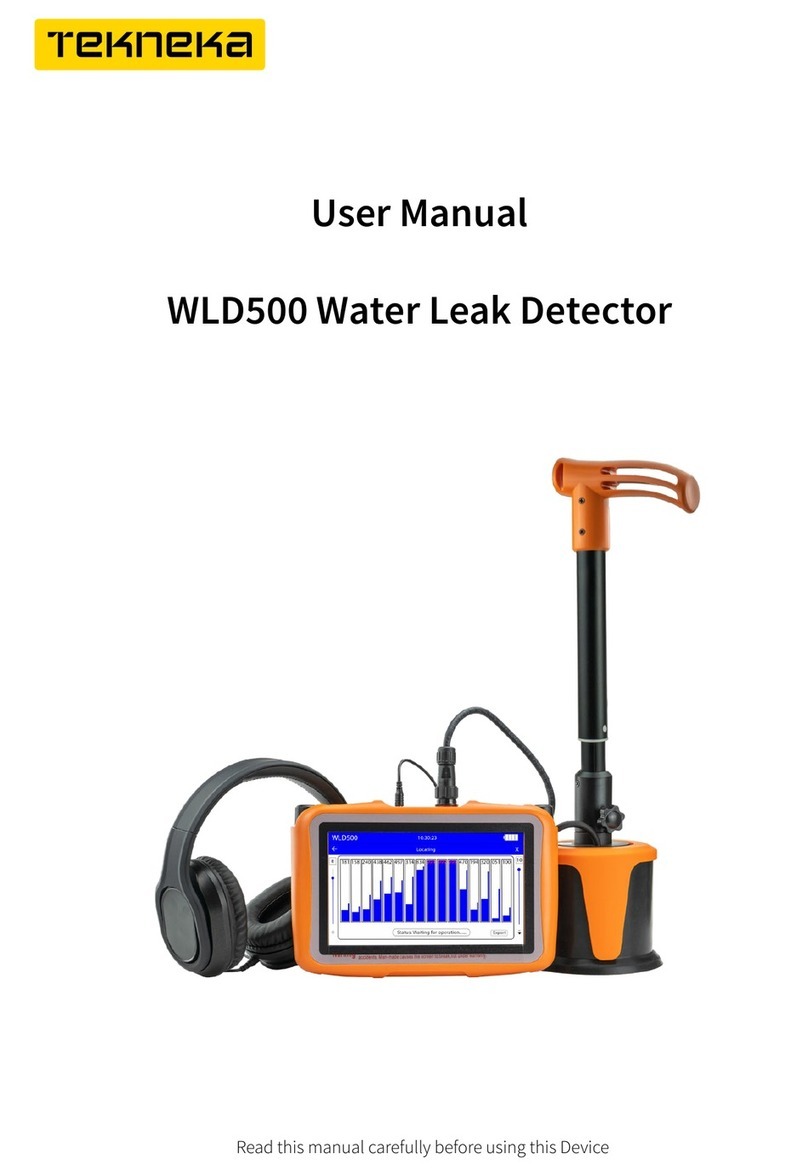heddier electronic Human Detector Flex User manual

Instruction Manual
Security made easy - Human Detector Flex 1
/
20
Instruction Manual
H
uman Detector
Flex
is a product of the
heddier electronic GmbH
Raiffeisenstraße 24
48734 Reken
Germany
Tel. +49 (0) 2864 95 178-0
Release I/2022
Specifications are subject to change without prior notice. All measurements have been made under specific conditions. Disclaimer: This
document, as well as all other documents (offers / specifications / cover letters / etc.), do not guarantee any functionality of our products
desired by the customer. heddier electronic GmbH does not guarantee any functionality or marketability desired by the customer. The
customer should be able to make his own decision on the basis of the transmitted documents.
heddier electronic GmbH supports him
in this, as it is given by the "General Terms and Conditions of
heddier electronic GmbH". In no case heddier electronic GmbH is
liable for damages and consequential damages caused by the use of the products and descriptive documents. Excluded from this are
damages caused by negligent behavior or damages that are regulated by superior laws.
Copyright by heddier electronic GmbH.Human Detector
is a registered trademark of
heddier electronic GmbH.

Instruction Manual
Security made easy - Human Detector Flex 2
/
20
Table of contents HDF-DOOR
Introduction ................................................................................................................... 3
Safety Instructions .......................................................................................................... 5
Human Detector Flex Sensors .......................................................................................... 6
HDF-DOOR ................................................................................................................ 7
Use and Operation Principle .................................................................................... 7
Design and Connections ......................................................................................... 8
Mounting Location and Installation .......................................................................... 9
System Login ....................................................................................................... 14
Maintenance and Care .......................................................................................... 17
Human Detector Flex Software ...................................................................................... 19
Terms of Warranty ........................................................................................................ 19
Procedure in Case of Warranty Repair ............................................................................ 19
Miscellaneous ............................................................................................................... 19
Help & Support ............................................................................................................. 20

Instruction Manual
Security made easy - Human Detector Flex 3
/
20
Introduction
Security and surveillance technology
for museums, exhibitions, private collections and luxury goods trade
Thank you for choosing the
H
uman Detector
Flex
alarm system.
A powerful, compact and quick-to-install security and surveillance system, it supports you in protecting your exhibits
and valuables. Whether paintings, sculptures or automobiles, the
H
uman Detector
Flex
system features a wide
range of applications.
Sensors and alarm modules are available for almost every task. These are extremely small and can be operated with
inexpensive lithium batteries, which last for up to 10 years.
(HDF
-
H
uman Detector
Flex
)
HDF-3D PROTECT
The HDF-3D PROTECT module detects the slightest vibrations (structure-
borne sound) and movements. This provides for the effective protection of
showcases, pedestals, technical exhibits and vehicles.
HDF-TOUCH
Approaching and touching objects can be easily detected with the
HDF-
TOUCH
module. The system is ideal for securing metallic objects, but can
also be used for other purposes.
HDF-HANG HDF-HANG
secures pictures and hanging objects on gallery rails.
HDF-OPTICAL
Pictures, paintings and other hanging objects can be secured sustainably,
simply and contact-free with
HDF-OPTICAL
.
HDF-EXTERN External sensors with an alarm output (NO or NC) can be connected directly
to the
HDF-EXTERN
module. This allows the
H
uman Detector Flex
System
to be extended as required.
HDF-WIRE
Securing with tear-off wires is in many cases the cheapest and quickest way to
secure "small items" against theft. The
HDF-WIRE
module supports up to two
signalling circuits.
HDF-DOOR HDF-DOOR
secures doors, flaps and inspection hatches.
HDF-SHOCK
The
HDF-SHOCK
module detects heavy blows, position changes and
vibrations.
HDF-REMOTE The HDF-REMOTE panic button allows for alarm messages to be easily and
invisibly sent by supervisors.
All alarm modules, with the exception of the HDF-REMOTE panic button, can additionally be operated with an
external power supply unit. The connection to the alarm centres (HDF-BUZZER and
HDF-SPEECH
) and the
HDF-
AMD alarm management system is wireless via radio. The communication that takes place in the 868 MHz range
uses a special modulation method that easily penetrates solid walls and large buildings. The ranges achieved here
are often several times greater than those that can be achieved with conventional systems.

Instruction Manual
Security made easy - Human Detector Flex 4
/
20
The HDF-BUZZER and HDF-SPEECH alarm centres
Two systems with different extension levels are available with the
HDF-BUZZER
and
HDF-SPEECH
alarm centres.
The basic system HDF-BUZZER enables the output of a loud alarm via a built-in piezo siren (buzzer). In addition,
three potential-free relay outputs are available. These can be individually controlled by the alarm modules. Alarm
messages are acknowledged and the system is armed and disarmed via an external input using a key switch.
The
HDF-SPEECH
alarm centre also has a voice output. Voice and sound messages are stored as .mps3 files and
used as alarm messages.
The
HDF-AMD
unit (AMD =
A
larm
M
anagement
D
evice) enables targeted forwarding of alarm messages to digital
terminal devices (e.g. Android tablets and smartphones) and to external services. A precise distinction is made here
as to who is responsible for which alarm. Likewise, the
HDF-AMD
in combination with the HDF-ANTIJAM
monitors
the radio network for interfering signals. The
HDF-AMD
is an open system. Future projects - such as the
transmission of measurement data (temperature, humidity, etc.), but also the connection to video control centres -
can be implemented.

Instruction Manual
Security made easy - Human Detector Flex 5
/
20
Safety Instructions
The
H
uman Detector
Flex
systems are designed and manufactured according to the latest quality and safety
standards. The following installation and usage instructions must be adhered to:
1. Get information about safety instructions
Read the entire instruction manual before operating the devices. Keep the instruction manual in a safe place.
Observe all safety instructions and notes in this instruction manual.
2. Penetration of objects or liquids
Avoid inserting or penetrating objects or liquids into the housings of the
H
uman Detector
Flex
systems. Should this
nevertheless occur, immediately disconnect the unit from the power supply (mains adapter or batteries) and send the
unit to an authorised dealer or to the manufacturer for inspection.
3. High temperatures
Keep the systems away from fire, heaters or other heat-producing devices. Never install the
H
uman Detector
Flex
sensors and devices in or on highly flammable objects such as fuel tanks.
4. Climate
The units have been designed for use at temperatures between -10°C to +50°C. Operating the devices outside this
temperature range must be avoided and cause permanent damage.
5. Cleaning
Do not use aggressive detergents or apply excessive moisture when cleaning the
H
uman Detector
Flex
sensors.
Follow the recommendations for the individual products.
6. Power supply
Do not connect the
H
uman Detector
Flex
units directly to a 230 volt mains supply. Only use a suitable power
supply (as included in the scope of delivery) or battery (type CR2450 or equivalent).
Important safety note!
The installation, programming and set-up must be carried out by trained and qualified personnel. Subsequent
changes during normal operation (such as the relocation ofHuman Detector
Flex
modules) can be carried out by
trained staff (not qualified personnel). However, the above-mentioned safety instructions and general rules of
electrical engineering must be observed. If unsure, ask your dealer or a qualified electrician.
heddier electronic GmbH does not guarantee or assume any responsibility for installations carried out by third
parties. This also applies if personnel was trained or in contact beforehand.

Instruction Manual
Security made easy - Human Detector Flex 6
/
20
Human Detector Flex Sensors
The
H
uman Detector
Flex
System includes a range of sensors. All sensors have an extremely compact design, low
energy consumption and a high radio range. The sensor housings provide good mechanical protection and are made
of shatter-proof ABS plastic with a UL94V-1 fire rating.
The following chapters describe the functions of the different types of sensors. Take the time to read the information
carefully. The right choice of sensor and the correct installation are important for the faultless operation.
Note:
Please contact us, if you cannot find a suitable type of sensor for your application. We will then try to develop a
possible selection or operational environment for you. We are able to adapt sensors to your needs or develop new
types of sensors in special cases.
H
uman Detector
Flex
is an open system and grows with the requirements of the
users.
heddier electronic GmbH offers upon request:
Training and coaching for interested customers.
Contact our sales department.

Instruction Manual
Security made easy - Human Detector Flex 7
/
20
HDF-DOOR
Use and Operation Principle
The
H
uman Detector
Flex
alarm sensor
HDF-DOOR
was developed for the use in museums and exhibitions. The
closing contact operates with an electronic reed relay. It reliably detects the closing and opening of doors and flaps.
An alarm is triggered in both cases.
The 10-year lifetime of the button cell battery and the long range of the integrated radio transmitter allow for easy use
or quick retrofitting.
The HDF-DOOR sensor - like other sensors from the
H
uman Detector Flex range - is attached by two screw
fittings. The magnet of the system also has two openings for the attachment with screws.
The
HDF-DOOR
sensor is suitable for the following protection tasks:
·
Protection of doors in showcases and exhibition rooms
·
Protection of inspection openings and flaps
·
... and more

Instruction Manual
Security made easy - Human Detector Flex 8
/
20
Design and Connections
The electronics of the
H
uman Detector
Flex
alarm module
HDF-DOOR
are located on a printed circuit board inside
the sensor housing. Open the housing cover by removing the four locking screws.
Do not remove the four screws
that connect the circuit board to the base plate of the housing.
There are no connecting elements or controls
below the circuit board that are necessary for operating the sensor electronics. If you have opened the housing,
please handle the sensor electronics with extreme care. Use tweezers to move the jumpers (micro connectors).
Terminal Operating Voltage Operating voltage 8-14 V, AC or DC, current 100 mA min.
The connection has internal reverse polarity protection.
Only use rigid connection cables or flexible cables with wire end ferrules and a cross-
section of 0.25 ... 0.34 mm2. The use of cables with larger cross-sections may cause
damage to the terminal.
Selecting the Operating Voltage Pin 1 and pin 2 connected -> external operating voltage
Pin 2 and pin 3 connected -> battery operation with CR2450 (standard setting)
Ensure that the micro connector is properly plugged in. It may come loose otherwise during
operation and deactivate the sensor module.
Antenna 1/4 lambda wire aerial for 868 MHz
Selecting the Alarm Channel Pin 1 and pin 2 connected -> alarm channel 1 (default setting)
Pin 2 and pin 3 connected -> alarm channel 2
Ensure that the micro connector is properly plugged in. It may come loose otherwise during
operation and deactivate the sensor module.
Test button Button for test transmissions
On/Off switch Slide switch for switching on and off
Use a pointed object (e.g. a biro) to operate the switch.
TRANSMITTING LED Flashing red once -> transmission mode
PROG LED Flashing green -> once per minute: message “Battery end of life imminent”
Version number at start-up
CR2450 battery Lithium button cell 3.0 V type CR2450

Instruction Manual
Security made easy - Human Detector Flex 9
/
20
Mounting Location and Installation
The power and flexibility of the
H
uman Detector
Flex
alarm system, amongst others, lies in its wireless radio
connection. Due to the transmission frequency and protocol, a high level of security is ensured. The modulation
process contributes to an increased range compared to products from various competitors. To ensure unrestricted
wireless radio operation, a few basic rules should be observed:
·
Do not mount the sensor module directly on metal surfaces or parts.
·If this is not possible, a minimum distance of approx. 40 cm should be kept from the metal surface.
This is important to ensure proper radiation of the transmitting antenna.
·
Choose an installation position of the sensor module so that there are no large metal parts between
the module and the radio control unit. This is critical, for example, when the sensor modules are
placed in display cases or vehicles.
·Choose an installation location so that you have access to the sensor module at all times. This is
necessary, for example, for checks and changing the batteries.
·Under no circumstances may unauthorised persons have free access to the sensor
modules. An exception can be sensor modules that inevitably trigger an alarm in the event of
contact (such as
HDF-OPTICAL
,HDF-TOUCH
and
HDF-3D PROTECT). Access by unauthorised
persons, however, should only be possible in exceptional circumstances.
Note:
The distance of 40 cm to metallic surfaces and parts can be reduced, if it is not possible to maintain this distance. In
this case, however, you should check the stability of the radio link very carefully.
Choosing the location for installation
The
HDF-DOOR
alarm module consists of two parts. Both, the sensor module and the permanent magnet, can be
fitted with two screws each. It is recommended, in many cases, to bond the two components to the surface at the
installation location, e.g. useful for aluminium framing.
We recommend double-sided adhesive mounting tape for fixing:
WÜRTH item: 0894909094
and
0894909005
(without guarantee)
This tape is transparent, adheres well to various surfaces, is largely emission-free and can be removed without
leaving any residue.
The sensor module must be mounted directly on the frame of the door edge or flap; the permanent magnet
accordingly on the door or flap. The position of the magnet in relation to the sensor housing is printed on. It is
important that the permanent magnet is in the correct position near the sensor housing. The distance must not
exceed 10 mm.
The
HDF-DOOR
alarm module triggers an alarm both when the door or flap is opened and when it is closed.
Note:
We recommend placing the permanent magnet on the moving door or flap. If the sensor module were to be installed
there, it could be damaged when the door is slammed.

Instruction Manual
Security made easy - Human Detector Flex
10
/
20
Selecting the Operating Voltage
The
H
uman Detector
Flex
alarm sensors have the option of being operated by battery or external power supply (see
"Design and Connections").
Battery Operation
Your sensor module is supplied with a CR2450 lithium button cell *1. Please insert these into the sensor module as
follows:
·
Check that the on/off switch is in the "Off" position. Otherwise, change the setting accordingly.
·
Remove the four outer screws and remove the cover from the sensor housing.
·Insert the included CR2450 battery into the holder. The positive terminal should point up. Apply
slight pressure to lock the battery into the holder. Check the proper engagement of the battery.
·Check whether pin 2 and pin 3 are connected to the micro connector in the "Operating voltage
selection" field.
·Close the sensor housing by inserting and tightening the four housing cover screws. Proceed
carefully and do not overtighten the screws.
·Switch on the sensor module. First, an alarm is automatically generated during start-up. The red
TRANSMITTING LED flashes once, the green PROG LED indicates the version status (e.g.
_short_
___long___
for version A).
Note:
Be careful not to damage the electronics on the circuit board when inserting the battery.

Instruction Manual
Security made easy - Human Detector Flex
11
/
20
Operation with External Power Supply Unit
In general, any power supply unit with an operating voltage of 8-14 V AC or DC can be used. The installer is
responsible to ensure compliance with the legal requirements relating to the power supply unit. These can vary
depending on country and region. The alarm modules contain an internal rectifier that is capable of operating with AC
voltages. The current of the power supply unit should be at least 100 mA. Ensure that the current is stable without
the operating voltage dropping.
Note:
heddier electronic GmbH supplies a suitable power supply unit with an output voltage of 12 V DC and a max.
current of 2000 mA (item:
NT-12-2A
).
To start up the alarm module with an external power supply unit, proceed as follows:
·Check that the on/off switch on the alarm module is in the "Off" position. Otherwise, change the
setting accordingly.
·
Remove the four outer screws and remove the cover from the sensor housing.
·Connect the two connection cables of the power supply unit to the operating voltage connection
terminal on the upper side of the sensor circuit board. Polarity is of no importance here (see above).
Important note:
Use tweezers or a small pair of pliers to insert the cable ends into the terminals. Only use a rigid
cable with a cross-section of 0.25 - 0.34 mm². It is also possible to use a flexible cable with
appropriately sized ferrules. Cables with a larger cross-section than 0.34 mm² can cause
permanent damage to the terminals.
The image shown may differ from the sensor module you are using. This does not affect the basic
procedure.
·
Check in the "Operating voltage selection" plug-in field whether pin1 and pin2 are connected to the
micro connector.
·
There is a recess in the housing cover through which you can lead the external voltage cable to the
outside.
·Close the sensor housing by inserting and tightening the four housing cover screws. Proceed
carefully and do not overtighten the screws. Make sure that the external power cable is properly
inserted and routed out.
·
Put the external power supply unit into operation.
·Switch on the sensor module. First, an alarm is automatically generated during start-up. The red
TRANSMITTING LED flashes once, the green PROG LED indicates the version status (e.g.
_short_
___long___
for version A).
Note:
Be careful not to damage the electronics on the circuit board when connecting the external power supply.
Press the corresponding retaining button on the terminal and carefully pull out the cable to remove an external voltage
cable. Use a suitable tool and proceed with care (see photo above).
*1: The CR2450 lithium batteries may not be supplied when shipping larger quantities of alarm sensors by
air freight.

Instruction Manual
Security made easy - Human Detector Flex
12
/
20
Increasing the range by externally placing the antenna on the sensor module
The
H
uman Detector Flex
alarm sensors have a built-in ¼ lambda wire aerial. This has been adapted in length for
the transmission frequency of 868 MHz. The antenna is delivered in the plastic housing of the sensor module. In
order to fit into the housing, the antenna is bent and placed between the components on the top of the circuit board.
Ensure that the antenna is exposed and not trapped by the housing cover. The function of the on/off switch and the
test button must not be restricted by the antenna.
Shadowing may occur in the radio propagation, as there are components, such as the lithium button cell, in the direct
vicinity of the antenna. If you find that the range of the sensor module is not sufficient, you should move the antenna
to the outside (external).
The use of a properly aligned external antenna increases the range considerably.
Proceed as follows:
·
Open the sensor housing by removing the four locking screws.
·
Carefully lift the wire aerial and pull it straight out from its attachment point.
·Look at the top of the plastic housing. There is a small recess. This enables you to guide the
antenna to the outside when the housing is closed. Place the wire aerial in such a way that it points
outwards at the correct position.
·Close the sensor housing by placing the upper part on top and closing the housing with the four
locking screws. Make sure that the wire aerial is routed through the recess.

Instruction Manual
Security made easy - Human Detector Flex
13
/
20
Note:
Ensure that the wire aerial is correctly aligned after attaching the sensor module to its final mounting location.
Depending on the location of the sensor housing outlet pull the antenna vertically up or down. This is
referred to as vertical alignment of the antenna. This should be the same for all sensor modules and alarm centres.
This enables an optimum range for radio transmission.
End of installation test
Perform a function test after completing all assembly work. For this purpose switch on the sensor module and trigger
an alarm. You can also press the test button, if this is not possible at this time due to the set-up. In both cases, the
red TRANSMITTING LED should briefly illuminate. This indicates transmission mode. If the sensor module is
already linked to an operating alarm centre, an alarm must be output by the centre (HDF-BUZZER or
HDF-
SPEECH
).
Check the complete set-up again, if an alarm cannot be triggered or the TRANSMITTING LED does not flash.
Possible causes for faults are:
·
The sensor module is not switched on.
·
"Battery mode" is selected and the battery is not inserted.
·
"Battery operation" is selected and the battery is empty (e.g. old battery).
·"Battery operation" is selected and the micro connector is not positioned on pin2 and pin3 of the
"Operating voltage selection" connector panel.
·
"External operating voltage" is selected and the power supply unit is not switched on.
·"External operating voltage" is selected and the micro connector is not positioned on pin1 and pin2
of the "Operating voltage selection" connector panel.
In very bright light conditions, you may not notice the red TRANSMITTING LED flashing. In this case, it is advisable
to shade the alarm sensor, e.g. by hand, and then repeat the test procedure.

Instruction Manual
Security made easy - Human Detector Flex
14
/
20
System Login
The
H
uman Detector
Flex
security system has three operating modes with different levels of performance.
EASY-Mode
operating modes for simple, small and medium size installations
MULTI-Mode
operating modes supported by powerful software
PROFI-Mode
high-end system with transmission to digital terminals
Switching between the operating modes is possible at any time. All components are upward compatible. This means
that you can switch to a higher operating mode at any time and use the previously purchased units without restriction.
You can also downsize larger security installations at any time or transfer theses into several, independent smaller
installations. The
H
uman Detector
Flex
Technology offers maximum return on your investment.
Registration of alarm sensors in EASY-Mode
EASY-Mode is the most simple operating mode. Due to its performance, it meets the demands of a wide range of
users. Up to 30 alarm sensors incl. hand-held transmitters can be connected in
EASY-Mode
to an
HDF-BUZZER
or
HDF-SPEECH
alarm centre. However, it is also possible to connect one alarm sensor with several alarm centres.
This is useful in applications where an alarm is to be output at several locations.
Pairing is done by pressing the pairing and test buttons. When these buttons are pressed, the system operating data
and identifiers are automatically shared. No additional configuration is required.
(+) Advantages EASY-Mode:
·
Pairing in seconds at the touch of a button
·
Fast training for inexperienced users
(-) Disadvantages EASY-Mode:
·
Limited to 30 alarm sensors max. per alarm centre
·
Deletion only in complete blocks (no individual deletion)
·All paired sensors offer the same alarm behaviour at the respective alarm centre. This may vary at
the individual alarm centres.
·
Project documentation must be created manually by the user
·
No active monitoring of vital signs (Heartbeat Monitoring, HBM)
To log in in
EASY-Mode
, proceed as follows:
·
Open the housing of the
HDF-BUZZER
or
HDF-SPEECH
alarm centre by unscrewing the 4 screws
on the back.
·
Switch on the alarm centre.
·
Switch on the alarm sensor to be registered.
·
Press the pairing button on the alarm centre once.
The RX LED next to the pairing button
flashes once to indicate pairing readiness.

Instruction Manual
Security made easy - Human Detector Flex
15
/
20
·Also press the test button on the sensor module once. Successful pairing is indicated by a
double flash of the red RX LED next to the pairing button.
·
Press the test button repeatedly. Each time it is pressed again, an alarm is triggered.
You can now register more sensors by repeating the process. Close the housing of the alarm centre after completion
of the work.
Important note:
The alarm centre has a maximum of 30 memory locations for identifiers of alarm modules. If all memory locations are
already occupied by older installations, you should first reset the alarm centre to its original state. All 30 occupied
memory locations are then deleted. Individual memory locations cannot be deleted. All alarm sensors must be re-
registered after a reset to the original state.
Attention - this procedure deletes all previous logins to this alarm centre!
To reset the alarm centre to its original state, proceed as follows:
·
Open the housing of the
HDF-BUZZER
or
HDF-SPEECH
alarm centre by unscrewing the 4 screws
on the back.
·
Switch on the alarm centre.
·Press the pairing button for at least 10 seconds. The RX LED next to the pairing button
illuminates continuously during the delete process. The RX LED flashes three times when the delete
process is finished. You can now stop pressing the pairing button. All connections to the previously
paired sensors are now deleted. The alarm centre is reset to its original state.
Note:
Please do not forget to provide documentation of the work you carried out. This is necessary in order to completely
understand the functionality of the security system.
Registration of alarm sensors in MULTI- and PROFI-Mode
Registration in
MULTI-
or
PROFI-Mode
is only possible with the
HDF-CONFIGURATOR
software, which is available
free of charge. The operating modes provide for maximum flexibility and performance. Up to 200 alarm sensors can
be connected to one alarm centre.
The entire security network is designed on the PC with the
HDF-CONFIGURATOR
Windows software. Once the
design is complete, the module identifiers are transmitted to the software. The control files for the alarm centres
(HDF-BUZZER
and
HDF-SPEECH
) and the
HDF-AMD
alarm management unit are generated from this. These are
then transferred to the relevant units (
HDF-BUZZER,
HDF-SPEECH
or
HDF-AMD
) via USB interface or WLAN.

Instruction Manual
Security made easy - Human Detector Flex
16
/
20
(+) Advantages MULTI or PROFI mode:
·
Support of up to 200 alarm sensors per alarm centre
·
Easy configuration with the
HDF-CONFIGURATOR
Windows software
·
Variable setting of alarm behaviour and networking
·
Automatic generation of complete project documentation
·
Forwarding of alarm messages to portable digital terminals of supervising staff
(-) Disadvantages MULT-I or PROFI-Mode:
·
Familiarisation with
HDF-CONFIGURATOR
software required
·
More complex installation of the
HDF-AMD
alarm management system
The exact procedure for registering sensors in MULTI- and PROFI-Mode is described in the chapter “
H
uman
Detector
Flex Software”.

Instruction Manual
Security made easy - Human Detector Flex
17
/
20
Maintenance and Care
The
H
uman Detector
Flex
alarm sensors require no special maintenance and care. However, as these are safety-
relevant systems, regular checks are recommended. The following should be noted here.
Regular testing of the alarm sensors
The functionality of the respective sensor module should be checked at regular intervals. An alarm must be triggered
on the sensor module for this purpose. The test frequency must be in accordance with the security plan of your
institution.
At least one test should be carried out per year. Record the test and archive the documentation.
Depending on your operating modes (
EASY-, MULTI-
or
PROFI-Mode
), check the below functions:
1. EASY- and MULTI-Mode installations
·
Trigger an alarm.
·
Check that the alarm reaches the designated alarm centres.
·
Check that no message “Battery end of life imminent” is output together with the alarm.
(double tone to
HDF-SPEECH
or
HDF-BUZZER)
·
Check that the alarm sensor is properly mounted.
·
Check that the alarm sensor shows no sign of external damage.
·
If the antenna has been placed out of the plastic housing (see: Mounting Location and Installation),
its correct alignment must be checked.
·
Check that no shielding objects have been retrofitted near the alarm sensors.
·If additional external cables are connected to the sensor (HDF-EXTERN,
HDF-WIRE
and
HDF-
TOUCH
), check for correct connection and cable routing.
·With the sensor for gallery rails
HDF-HANG
, also check for correct connection to the retaining
rope.
2.
Additional tests in PROFI mode
·
Check whether the alarm reaches the intended terminals (smartphones of security personnel).
·
Check that no message “Battery end of life imminent” has been sent.
·
Note the reception field strength of the alarm module and compare it with older recorded data.
Note!
If the value deviates significantly from older recorded data or if the value is below -90 dBm (e.g. -96
dBm), you should check the design. Possible causes of errors are misaligned antennas or shielding
objects within the transmission path.
It is important that the inspection work is carried out diligently by instructed personnel. We can carry out
this work on request.
Please contact our sales department should you be interested in this service.
Unless the alarm modules are powered with an external power supply unit, batteries may have to be replaced when
necessary.
The calculated lifetime of the batteries listed in the data sheets is only for reference. It can be
influenced positively or negatively by factors such as temperature, alarm frequency, battery age and original battery
capacity.

Instruction Manual
Security made easy - Human Detector Flex
18
/
20
Changing the batteries of the alarm modules
·
Switch off the alarm module.
·
Dismantle the alarm sensor for access to the screw fitting on the back.
·
Loosen the four outer screws and remove the cover from the sensor housing.
·
Remove the battery from the housing. Carefully push it out of the holder by pressing on the edge of
the battery.
·
Insert the new CR2450
battery into the holder. The positive pole should point upwards. Apply slight
pressure for the battery to lock into the holder. Ensure that the battery is properly latched.
Note!
Only use branded batteries of the
CR2450
type. Inexpensive batteries from unknown manufacturers
often have a significantly lower capacity and a higher self-discharge.
Defective batteries can leak.
The batteries contain mercury and there is the risk of poisoning if touched.
·
Close the sensor housing by inserting and tightening the four housing cover screws. Proceed
carefully and do not overtighten the screws.
·
Install the sensor system again in its old position.
·
Check - if connected - all additional external cables (
HDF-WIRE
,HDF-EXTERN
and
HDF-TOUCH
).
Check - if necessary - the connection to the retaining rope at the
HDF-HANG
.
·
Switch on the sensor module. During switch-on an alarm is generated automatically. You can also
press the test button on the sensor. This also triggers an alarm.
·
Provided that the generated alarm messages have reached their destination, you should now test
the entire installation again and trigger an alarm. Check whether the alarm reaches its destination
(HDF-BUZZER,
HDF-SPEECH
or terminal device of the room security personnel).
·
Document the battery change.
Note!
Be careful not to damage the electronics on the circuit board when changing the battery.
Cleaning the sensor housings
Normally, it is not necessary to clean the housing. Should it become necessary, we recommend the use of a mild
glass cleaner.
Please proceed as follows:
·Take a sufficiently large piece of kitchen paper and spray the glass cleaner onto the paper once or
max. twice.
·
Spread the cleaning liquid on the kitchen paper and carefully wipe the surface of the sensor housing
with the paper.
·
Then check the function of the alarm module by triggering a test alarm.
Note!
Do not use solvents to clean the sensor housing. Do not spray the housing directly. Moisture must not penetrate the
sensor housing. In case of moisture penetration, dry the housing and check its correct function.

Instruction Manual
Security made easy - Human Detector Flex
19
/
20
In case of dirt or moisture in the sensor housing and its function is permanently compromised, please
contact our technical customer service immediately.
Terms of Warranty
The warranty period is 2 years from the date of purchase shown on the invoice.
Different warranty conditions
for commercial customers result from the General Terms and Conditions of
heddier electronic GmbH
. In the event
of a warranty claim, the user is entitled to send the unit to their authorised dealer for repair. For each repair within the
warranty period, a proof of purchase needs to be presented to the authorised dealer. The services included in the
warranty cover all spare parts and labour costs necessary for repair.
Improper use or faulty installations are not covered by the terms of this warranty. In addition, technical modifications
to the unit by unauthorised persons will render any claim invalid. The manufacturer is not liable for damage caused
during transport to the service workshop.
The statutory warranty rules are not affected by the guarantee scheme. No guarantee or warranty claim exists for
units where the serial number labels have been removed or the prescribed conditions of use and operation have been
violated.
Procedure in Case of Warranty Repair
Defective
H
uman Detector
Flex
components should be delivered to the authorised dealer in the original box or
equivalent packaging. Attach a copy of the purchase invoice. No responsibility can be assumed for safe delivery by
the carrier. It is therefore recommended to take insurance against loss, theft and damage during transit.
The
H
uman Detector
Flex
components supplied cannot be returned after the original cardboard box has been
opened or the seal has been damaged. Devices without a serial number decal are excluded from the warranty and
guarantee agreement.
Miscellaneous
Changes to technical specifications and errors are possible. The manufacturer reserves the right to change the
technical specifications of individual devices and components at any time and without providing reasons. The
copyright of this document is owned by heddier electronic GmbH. The production of copies for work support or
maintenance of the
H
uman Detector
Flex
security systems is permitted at any time. The production of copies for
distribution to third parties, even in excerpts - by whatever means - is only permitted after written approval.
Windows is a registered trademark of Microsoft Inc, USA.
iOS is a registered trademark of Apple Inc, USA.
Android
is a registered trademark of Google LLC, USA.
Human Detector is a registered trademark of heddier electronic GmbH.

Instruction Manual
Security made easy - Human Detector Flex
20
/
20
Help & Support
Despite its simple operation, many users find modern security technology quite complex and can grasp the concept
to some extend only. The diversity of museums and collections requires an expert and the task-related installation of
the
H
uman Detector
Flex
technology. The aim is to create a security system that is optimized to customer needs. If
you are in charge of the installation, we would like to make the following suggestions:
Suggestion Thoroughly read the operating instructions to understand the various functions and special
features of the individual components. Compare the delivered systems with the
documentation.
Suggestion
It often is beneficial to try out an installation outside the exhibition first. Build small functional
units and put them into operation. Change the settings of the various components and
observe the outcome.
Suggestion Plan your security system in advance. Create a diagram of which sensors collaborate with
which alarm devices. Use your diagram as a guide during the installation. If you make
changes to your concept - which is very likely - enter them immediately in your diagram.
Remember, accurate project documentation is a prerequisite for all future work on
your security system.
Questions
Please direct any questions to your retailer first. They should be trained and be able to
answer your questions. If not, they will receive the necessary support from us.
Training Take advantage of our training opportunities. We will train you and your colleagues in the
installation and use of the
H
uman Detector
Flex
security technology. The training courses
can take place at your premises or at our training centre in Coesfeld (near Münster in North
Rhine-Westphalia, Germany). Training can be combined with the initial installation of your
security system, if required. Our sales department will be happy to inform you about costs,
conditions and dates for technical training.
Support Do you need help quickly? Our technical support can be reached by phone Monday to
Thursday between 8.00 and 17.00 or on Friday until 15.00. Training and technical
support can be provided by email, phone or video conference (Microsoft Teams).
Technical Support: heddier electronic GmbH
Phone: +49 2864 95 178-0
Important! Check the functions of all installed components at regular intervals. This is important
in order to detect deviations from normal operation and possible errors at an early stage.
Prepare and archive a test protocol. The tests can range from triggering a test alarm to
checking the radio links and battery voltages. We will tell you about the exact procedure in
our training courses.
heddier electronic GmbH reserves the right to make different service agreements with museums, collections,
private collectors and other institutions. These agreements may include special services, response and repair times.
All such agreements shall be in writing and signed. Verbal agreements outside the scope of the normal use of our
systems and support are only valid after written confirmation.
Other manuals for Human Detector Flex
4
This manual suits for next models
11
Table of contents
Other heddier electronic Security Sensor manuals
